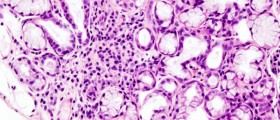Opsoclonus myoclonus syndrome is a very rare neurological disorder that still remains a mystery to the modern science. The exact causes behind this disease are poorly understood, and scientists believe it is a result of an autoimmune process involving the nervous system. In other words, it appears that opsoclonus myoclonus syndrome occurs when the human body mistakenly starts to attack its own parts, in this very case – the nervous system. The disease is very rare, and it affects just one per 10.000.000 people each year. The disease is typically diagnosed in childhood. Opsoclonus is an unusual disorder of eye movement, in which both eyes move involuntarily. Myoclonus, on the other hand, means muscle twitches and ataxia, or incoordination.
Symptoms of the opsoclonus myoclonus syndrome
A typical symptom of this disease is a rapid and involuntary eye movement in both horizontal and vertical directions. The movements of the eyes are typically unpredictable and may involve quick rotations of the eyes. The disease also manifests in brief and involuntary twitching of particular muscles, or even whole muscle groups. Patients may also suffer from cerebellar ataxia, which is a lack of coordination of muscle movements. Changes in the language skills are also noticeable as patients often have impairment of speech and of comprehension of speech, caused by brain damage. Sometimes, the patient may acquire language skills but completely lose them at some point in life. This symptom is also known as mutism. Other symptoms include irritability, lethargy, drooling, vomiting and sleep disturbances.
Causes of the opsoclonus myoclonus syndrome
In almost half of the cases, this condition occurs in association with neuroblastoma. Neuroblastoma is a common extracranial solid cancer that usually occurs in infants and children younger than two years old. This tumor arises from neural crest element of the sympathetic nervous system. However, most of the children with this disease have neuroblastoma and ganglioneuroblastoma tumors, which occur often in the chest, but also in the abdomen or pelvis.Some of the scientists believe there is a strong association between viral infections caused by Epstein-Barr, Coxsackie B, St. Louis encephalitis, and other viruses.
However, there is no explanation to the question how does a tumor or viral infection cause a brain malfunction such as the opsoclonus myoclonus syndrome.
Treatment
Despite the pronounced symptoms, diagnosis for the opsoclonus myoclonus syndrome can be very slow. This is primarily because the disease is very rare, and because it occurs at an average of 19 months. Early diagnosis is important to start with the treatment on time. Treatment usually includes adrenocorticotropic hormone therapy, or removal of the tumor, if it is present. In most of the cases, treatment of the underlying cause of the disorder will result in an improvement of symptoms. However, sometimes the symptoms recur without any warning.

















Your thoughts on this
Loading...